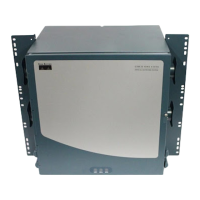20-47
Cisco ONS 15454 Procedure Guide, R5.0
March 2005
Chapter 20 DLPs A300 to A399
DLP-A362 Create a Four-Fiber BLSR Using the BLSR Wizard
If CTC determines that a BLSR cannot be created, for example, not enough optical cards are installed or
it finds circuits with path protection selectors, a “Cannot Create BLSR” message appears. If this occurs,
complete the following steps:
a. Click OK.
b. In the Create BLSR window, click Excluded Nodes. Review the information explaining why the
BLSR could not be created, then click OK.
c. Depending on the problem, click Back to start over or click Cancel to cancel the operation.
d. Complete the “NTP-A40 Provision BLSR Nodes” procedure on page 5-10, making sure all steps are
completed accurately, then start this procedure again.
Step 6 In the network graphic, double-click a BLSR span line. If the span line is DCC connected to other BLSR
cards that constitute a complete ring, the lines turn blue. If the lines do not form a complete ring,
double-click span lines until a complete ring is formed. When the ring is DCC connected, go to Step 7.
Step 7 Click Next. In the Protect Port Selection section, choose the protect ports from the West Protect and
East Protect columns.
Step 8 Click Finish. If the BLSR window appears with the BLSR you created, go to Step 9. If a “Cannot Create
BLSR” or “Error While Creating BLSR” message appears:
a. Click OK.
b. In the Create BLSR window, click Excluded Nodes. Review the information explaining why the
BLSR could not be created, then click OK.
c. Depending on the problem, click Back to start over or click Cancel to cancel the operation.
d. Complete the “NTP-A40 Provision BLSR Nodes” procedure on page 5-10, making sure all steps are
completed accurately, then start this procedure again.
Note Some or all of the following alarms might briefly appear during BLSR setup: E-W MISMATCH,
RING MISMATCH, APSCIMP, APSDFLTK, and BLSROSYNC.
Step 9 Verify the following:
• On the network view graphic, a green span line appears between all BLSR nodes.
• All E-W MISMATCH, RING MISMATCH, APSCIMP, DFLTK, and BLSROSYNC alarms are
cleared. See the Cisco ONS 15454 Troubleshooting Guide for alarm troubleshooting.
Note The numbers in parentheses after the node name are the BLSR node IDs assigned by CTC. Every
ONS 15454 in a BLSR is given a unique node ID, 0 through 31. To change it, complete the
“DLP-A326 Change a BLSR Node ID” task on page 20-16.
Step 10 Return to your originating procedure (NTP).

